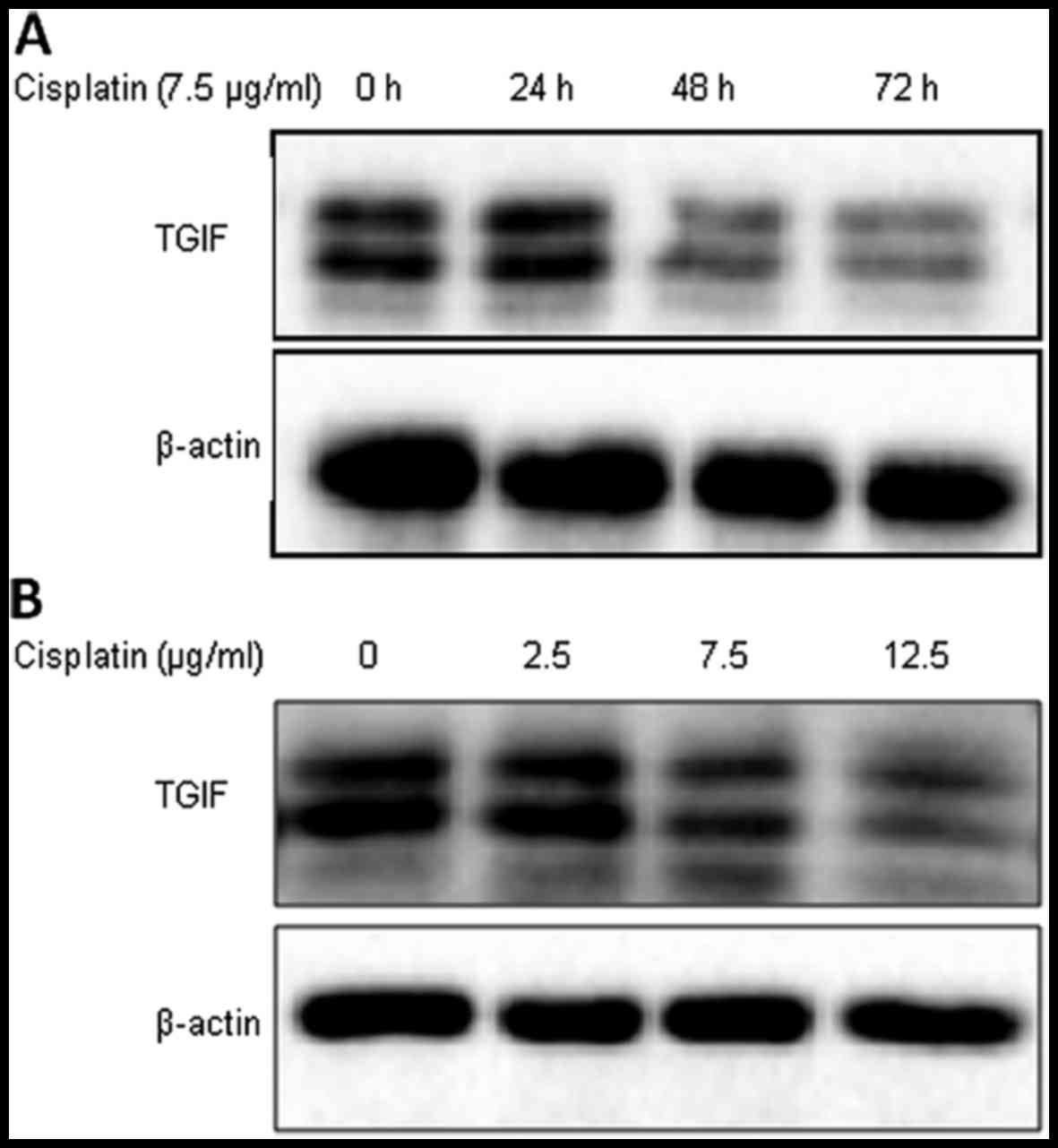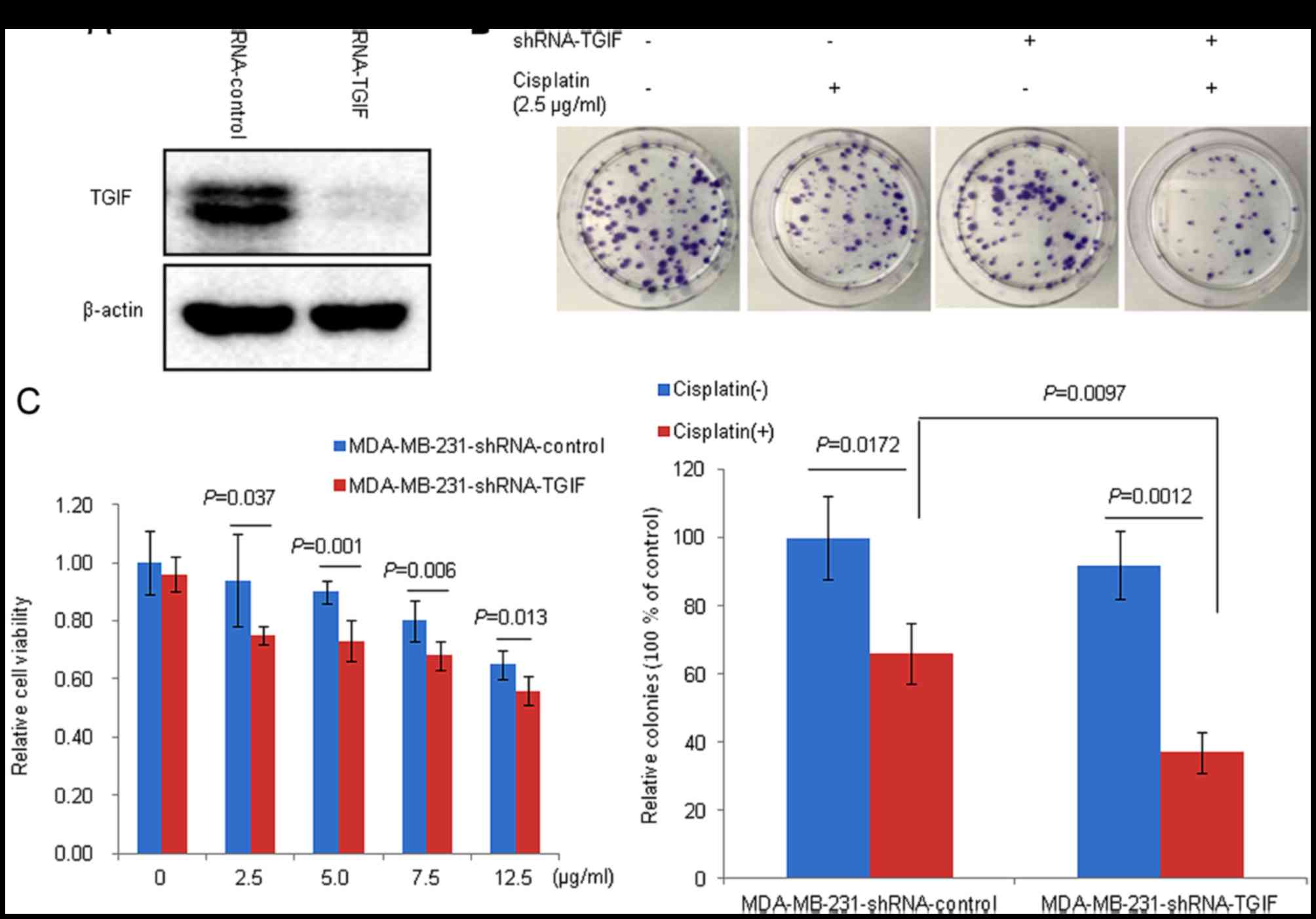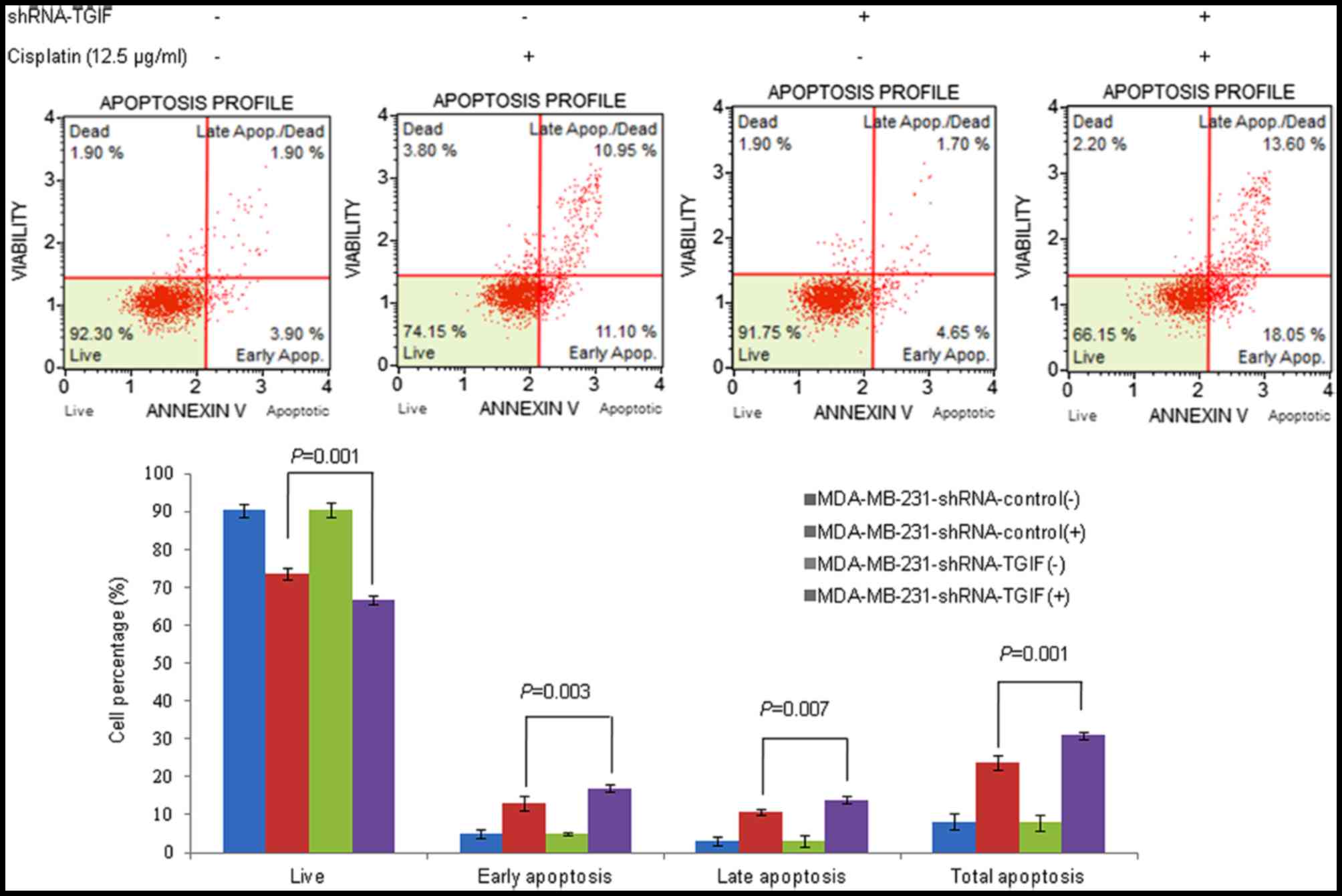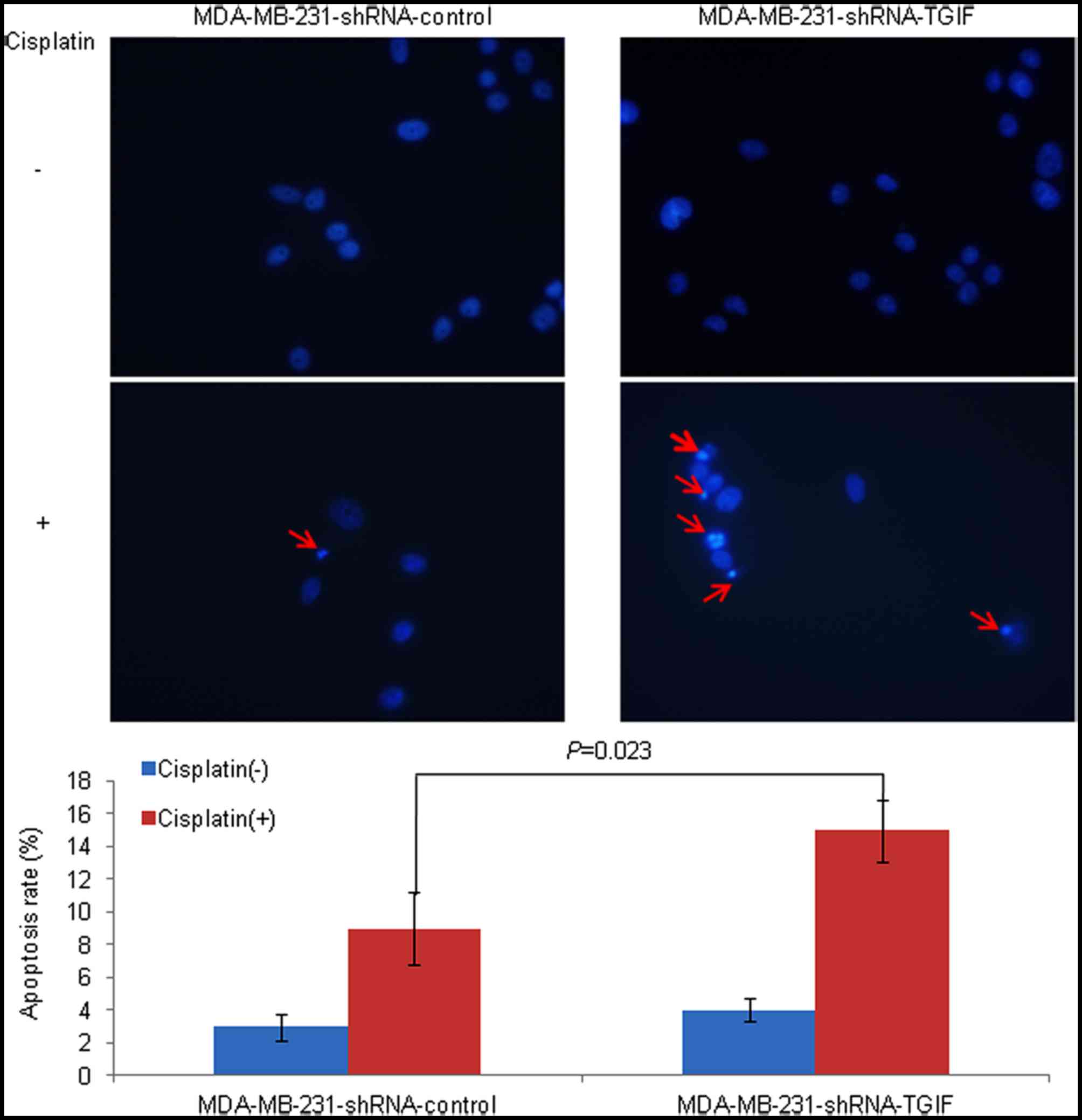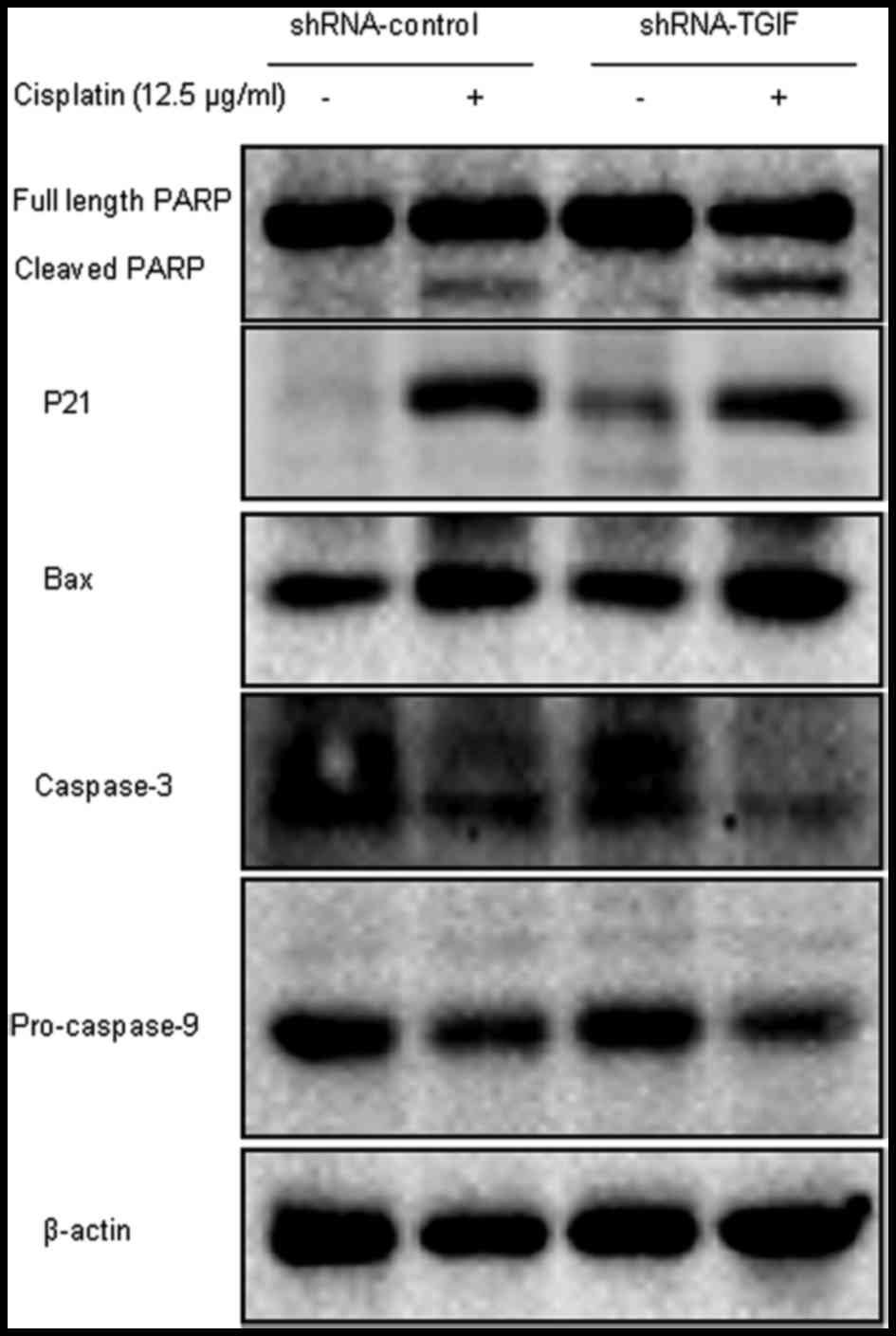Silencing of TGIF sensitizes MDA‑MB‑231 human breast cancer cells to cisplatin‑induced apoptosis
- Authors:
- Published online on: January 19, 2018 https://doi.org/10.3892/etm.2018.5780
- Pages: 2978-2984
-
Copyright: © Pan et al. This is an open access article distributed under the terms of Creative Commons Attribution License.
Abstract
Introduction
Triple-negative breast cancer (TNBC) is one breast cancer subtype that is characterized by the lack expression of estrogen receptor (ER), progesterone receptor (PR), and human epidermal growth factor receptor 2 (HER2) (1,2). TNBC accounts for 9–21% of all breast cancers and has higher metastatic and recurrence rates and a poorer prognosis than other breast cancer subtypes (2–5). Currently, chemotherapy is the only option for treating malignant breast cancer because of the lack of targeted molecules for disease treatment (6,7). Among the chemotherapy drugs, platinum agents have received much attention in the treatment of TNBC (8). However, the growing chemotherapy resistance and side effect problems restrict its clinical application (9,10). Therefore, exploring the underlying mechanisms of drug resistance and seeking a new target for TNBC chemotherapy is needed.
TG-interacting factor (TGIF), a member of the three-amino-acid loop extension (TALE) subfamily of atypical homeodomain proteins, is involved in multiple signaling pathways (11–17). Since TGIF was identified to be involved in holoprosencephaly development (18), it has been implicated in diverse biological and pathological functions. Recently, numerous studies have focused on the potential roles of TGIF in tumor development, invasion and migration in various types of cancers, including lung cancer (19–21), liver cancer (22,23), ovarian cancer (24), leukemia (25), gastric carcinoma (26), upper urinary tract urothelial carcinoma (27) and esophageal squamous cell carcinoma (28). However, research regarding the correlation of TGIF protein with TNBC is limited. Prof. Atfi's laboratory revealed that TGIF expression was much higher in TNBC patients compared with normal tissue or other breast cancer subtypes. Moreover, the elevated levels of TGIF correlated with a high relapse and mortality rate of TNBC patients (29,30). Kwon et al reported that targeted interference of SIN3A-TGIF function by SID decoy treatment inhibited Wnt signaling and invasion in TNBC cells (31). Together, previous papers suggested that TGIF protein might be a target for TNBC chemotherapy. To the best of our knowledge, there is no publication focusing on the relationship between TGIF silencing and cisplatin-induced apoptotic sensitivity in TNBC cells. In the present study, we used the representative TNBC cell line of MDA-MB-231 to observe the effects of TGIF silencing on cisplatin-induced apoptosis.
Materials and methods
Cell culture and cell transfection
The MDA-MB-231 cell line was maintained in our laboratory and cultured in DMEM supplemented with penicillin (100 U/ml), streptomycin (100 µg/ml), 10% fetal bovine serum (FBS), and 2 mM L-glutamine in a humidified atmosphere that contained 5% CO2 at 37°C. TGIF shRNA human (h) lentiviral particles (sc-36659-V) and control shRNA lentiviral particles-A (sc-108080) were obtained from Santa Cruz Biotechnology, Inc. (Dallas, TX, USA). The shRNA lentiviral particles against TGIF were infected into MDA-MB-231 cells according to the manufacturer's instructions. Next, the stable clones expressing shRNA were initially selected by 10 µg/ml of puromycin for three weeks (Gibco; Thermo Fisher Scientific, Inc., Waltham, MA, USA). The TGIF expression level of the infected cells was detected by western blot to confirm the transfection efficiency. Cells that were stably transfected with the TGIF shRNA (h) lentiviral particles and control shRNA lentiviral particles were named MDA-MB-231-shRNA-TGIF cells and MDA-MB-231-shRNA-control cells, respectively.
Western blot analysis
Cell lysates were prepared in a RIPA buffer (Pierce; Thermo Fisher Scientific, Inc.), and a BCA protein assay (Pierce; Thermo Fisher Scientific, Inc.) was conducted to quantify the protein concentration. The samples were then separated on a 10% sodium dodecyl sulfate-polyacrylamide electrophoresis gel (SDS-PAGE) and proteins were transferred onto a nitrocellulose (NC) membrane. After blocking with 5% bovine serum albumin (BSA)/Tris-buffered saline Tween-20 (TBST) for 1 h, the membrane was incubated with primary antibody overnight at 4°C, followed by adsorption to peroxidase-coupled protein G (ZSGB-BIO, Beijing, China) for 1 h at room temperature. Antibodies against TGIF (sc-9084) and p21 (sc-397) were purchased from Santa Cruz Biotechnology, Inc., and antibodies against PARP (no. 9532S), Bax (no. 2772S), caspase-3 (no. 9665S) and caspase-9 (no. 9508S) were obtained from Cell Signaling Technology. Immunoreactive bands were visualized with a Bio-Rad Clarity™ western ECL substrate (Bio-Rad Laboratories, Inc., Hercules, CA, USA). Antibody to β-actin (sc-47778; Santa Cruz Biotechnology, Inc.) was used as a loading control.
MTT assay
Cell viability was determined by MTT assay. We collected the MDA-MB-231-shRNA-TGIF cells and MDA-MB-231-shRNA-control cells at a density of 5×104/ml and then plated cells in 96-well plates at a density of 5×103 cells per well (6-well per group). After incubation in culture medium for 24 h, the culture medium was replaced with the following concentrations of cisplatin at 0, 2.5, 5.0, 7.5 and 12.5 µg/ml and maintained for 48 h. Four h before the cisplatin treatment finished, 10 µl of 5 mg/ml MTT were added to each well. Then, 150 µl of DMSO were added to each well and the absorbance was determined on a micro-plate reader (Multiskan Ascent;. Thermo Labsystems; Thermo Fisher Scientific, Inc.) at 492 nm.
Annexin V and dead cell assay
Annexin V and dead cell assay was used to determine the cell populations in the apoptosis stage, including the early apoptotic cells and the late apoptotic cells. For the induction of apoptosis, cells were seeded in 60-mm plates and cultured for 24 h at 37°C and then incubated for 48 h with cisplatin (12.5 µg/ml). Cells were trypsinized and resuspended in at least 1% FBS. The cell samples were incubated with Muse™ annexin V and dead cell reagent for 20 min at room temperature in the dark. The apoptosis rate was measured by the Muse™ Cell Analyzer with the Muse™ annexin V and dead cell software module.
Cell apoptosis analysis by hoechst 33258
The Hoechst staining kit (Beyotime Institute of Biotechnology, Haimen, China) was used to detect the state of nucleus condensation. Cells were seeded onto cover slides in 6-well plates overnight at 37°C and then treated with 12.5 µg/ml of cisplatin for 48 h followed by adding 0.5 ml of fixation fluid for 30 min. After washing with phosphate-buffered saline (PBS) twice, 0.5 ml of Hoechst 33258 were added to the plate and incubated for 5 min. The stained cells were washed with PBS twice and then the nuclear morphology was observed under a fluorescence microscope (Zeiss AG, Oberkochen, Germany). The apoptotic cells showed condensed and fragmented nuclei.
Colony formation assay
A total of 400 cells were plated in 60-mm plates. After plating for 72 h, cells were treated with 2.5 µg/ml of cisplatin for 4 h and washed with HANKs three times. Cells were maintained in an incubator of 5% CO2 at 37°C for 18 days. The culture medium was changed every three days. At the end of the experiments, cells were washed with PBS and fixed with methanol for 30 min at room temperature and then stained with Giemsa for 30 min at room temperature. Colonies with more than 50 cells were counted under an inverted microscope (Leica Microsystems GmbH, Wetzlar, Germany).
Statistical analysis
SPSS 13.0 software (SPSS, Inc., Chicago, IL, USA) was used for statistical analyses. All data were expressed as the mean ± standard deviation (SD). A Student's t test was applied to evaluate the difference of relative cell viability between groups at each dose of cisplatin treatment (0, 2.5, 7.5 and 12.5 µg/ml) and one-way ANOVA (LSD for post-hoc test) was applied to evaluate the difference among groups in additional experiments. P<0.05 was considered to indicate a statistically significant difference.
Results
Cisplatin decreased the expression of TGIF protein in MDA-MB-231 cells
As shown in Fig. 1, the expression of TGIF protein was suppressed by cisplatin treatment from 48 h in MDA-MB-231 cells (Fig. 1A). We also tested the level of TGIF protein expression under different concentrations of cisplatin; Fig. 1B shows that cisplatin treatment suppressed TGIF protein expression in a dose-dependent manner in MDA-MB-231 cells.
TGIF silencing efficiency in MDA-MB-231 cells
Fig. 2A shows that the level of TGIF protein expression in shRNA-TGIF infected cells was markedly decreased compared with control cells. This suggested a successful construction of a stable TGIF-silenced MDA-MB-231 cell line.
Silencing TGIF increased the cytotoxicity of MDA-MB-231 cells to cisplatin
Fig. 2B and C demonstrated the effects of TGIF silencing on cisplatin-induced cytotoxicity. Our data showed that TGIF silencing significantly impeded cell proliferation in MDA-MB-231 cells compared with the control groups in the presence of cisplatin (Fig. 2C). Furthermore, we observed that there were significantly decreased colonies in the MDA-MB-231-shRNA-TGIF group compared with the MDA-MB-231-shRNA-control group in the presence of cisplatin (Fig. 2B).
Silencing TGIF increased the apoptotic sensitivity of MDA-MB-231 cells to cisplatin
Fig. 3 indicated the effects of TGIF silencing on cisplatin-induced apoptosis in MDA-MB-231 cells by annexin V and dead cell assay. Our results showed that the percentage of apoptosis in MDA-MB-231-shRNA-TGIF cells was much higher than that in MDA-MB-231-shRNA-control cells with the treatment of 12.5 µg/ml cisplatin (Fig. 3). Similar results were obtained from the Hoechst 33258 staining assay. The MDA-MB-231-shRNA-TGIF cells treated with cisplatin contained more cells in the apoptotic morphological stages, while the control cells treated with cisplatin were uniformly stained. After counting the cells, a significantly increased percentage of apoptotic monocytes was observed in MDA-MB-231-shRNA-TGIF cells compared with MDA-MB-231-shRNA-control cells with the treatment of cisplatin (Fig. 4).
Silencing TGIF regulated the expression of cell apoptosis-related proteins with the treatment of cisplatin
As illustrated in Fig. 5, the increased expression of cleaved PARP, p21 and Bax proteins and decreased expression of caspase-3 and pro-casepase-9 proteins were observed in MDA-MB-231-shRNA-control cells compared with the cisplatin-untreated group with the treatment of 12.5 µg/ml cisplatin. However, only PARP and caspase-3 were correlated with the cisplatin-induced apoptosis mediated by TGIF protein in MDA-MB-231 cells.
Discussion
Recently, several documents have shown that TGIF might mediate a critical feature of chemoresistance in response to the chemotherapy drugs of arsenic trioxide (As2O3, ATO) and gemcitabine. Published studies showed that ATO induced cell apoptosis via the ERK1/2 signaling and the TGF-β/Smad pathway, and enhanced p21WAF1/CIP1 (p21) expression in human keratinocytes and hepatocellular carcinoma cells. However, this effect could be inhibited by ATO-induced TGIF expression through the recruitment of the HDAC1/TGIF complex to the p21 promoter (32,33). In addition, among the patients with upper tract urothelial carcinoma treated with the gemcitabine and cisplatin systemic chemotherapy, increased expression of TGIF was significantly associated with worse oncological outcomes. Higher disease progression and cancer-related death rates in the TGIF positive group were 100 and 83.3%, respectively, compared with 63.6 and 27.3% in the TGIF negative group (34).
Cisplatin, also called cis-diamminedichloroplatinum (II), is a representative of the platinum drugs. Since its cytotoxic properties were discovered in the 1960s, it has gained attention in the systemic treatment of cancer cells and now it has been one of the most compelling chemotherapy drugs (6,35). Cisplatin crosslinks with the purine bases on the DNA in the nucleus and yields four main cisplatin-DNA adducts, including interstrand crosslink, 1,2-intrastrand cross-link, 1,3-intrastrand crosslink and DNA-protein cross-links (36,37). Cisplatin-DNA adducts can be recognized by several families of proteins and then can interfere with DNA repair mechanisms, induce cell cycle arrest and DNA damage, and subsequently induce cell apoptosis in cancer cells (38).
Previous studies have shown that ectopic expression of several genes is associated with cisplatin therapeutic sensitivity in MDA-MB-231 cells. Zhou et al reported that silencing eIFE4 enhanced the chemosensitivity of MDA-MB-231 cells to cisplatin (39). Yang et al showed that knockdown of HAX-1 via RNA interference decreased the IC50 level of cisplatin by 70.91% in MDA-MB-231/CR cells (40). Hong et al demonstrated that knockdown of BCL2L12 and BCL2L12A dramatically inhibited cisplatin-induced apoptosis in MDA-MB-231 cells (41). Zhang et al indicated that MiR-363 sensitized cisplatin-induced apoptosis targeting in Mcl-1 in MDA-MB-231 cells; moreover, cells transfected with Mcl-1 expression plasmid abolished the sensitization effects of MiR-363 to cisplatin-inducing cytotoxicity (42). Wu et al showed that MiR-153 promoted MDA-MB-231 cell apoptosis treated with cisplatin by targeting HECTD3. Moreover, stable overexpression of HECTD3 abrogated the sensitization effects of MiR-153 to cisplatin treatments (43). Together, combined treatment with gene therapy and chemotherapeutic drugs might effectively enhance chemotherapy-induced cytotoxicity in TNBC cells and may have great clinical significance.
In the present study, we explored the correlation of TGIF silencing with cisplatin chemosensitivity in MDA-MB-231 cells. Our data indicated that TGIF protein expression was markedly decreased in a time- and dose-dependent manner in MDA-MB-231 cells with the treatment of cisplatin, however, we did not observe cisplatin had obvious effects on the expression of TGIF mRNA (0, 2.5, 7.5 and 12.5 µg/ml for 48 h or 7.5 µg/ml for 0, 24, 48 and 72 h; data not shown). The mechanism underlying cisplatin repressing TGIF expression should be explored in future studies. We observed that cell proliferation was significantly inhibited in TGIF-silenced cells treated by cisplatin. Furthermore, silencing TGIF reduced the formation of colonies of MDA-MB-231 cells in the presence of cisplatin compared with controls. In addition, TGIF silencing dramatically increased the cisplatin-induced apoptosis rate as measured by flow cytometry assay as well as the Hoechst staining assay. These data revealed that TGIF might be a potential therapeutic target for cisplatin treatment in MDA-MB-231 cells. For further investigation, the expression of apoptosis-related proteins was measured by western blot analysis. The expression of PARP and caspase-3 proteins was involved in the event that silencing TGIF protein enhanced cisplatin-induced apoptosis.
As is well-known, caspase-3 is the key molecule in the execution phases of apoptosis (44,45). Caspase-3 is usually present in the cytoplasm in the form of an inactive 32-kDa precursor; after the stimulation of the apoptosis signal, it can produce 17 kDa (p17) and 12 kDa (p12) subunits and later form a mature enzyme that is responsible for the proteolytic cleavage of many key proteins. PARP is one of the main cleavage targets of caspase-3 in vivo; the cleavage is typically a marker of cells undergoing apoptosis. When a cell is engaged in cell apoptosis, autoribosylated PARP is cleaved by caspases into the 89 kDa C-terminal fragment and the 24 kDa N-terminal fragment; these fragments interact with intact PARP and block the function of PARP on DNA repair and the maintenance of genomic stability (46,47). Presently, we found that caspase-3 and PARP cleavage were involved in cisplatin-induced apoptosis mediated by TGIF protein. However, the mechanisms that are involved should be elucidated further.
We should acknowledge that there are some limitations in our present study. First, only one cell line of MDA-MB-231 human TNBC has been applied to investigate the effects of TGIF knockdown on cisplatin-induced apoptosis; other breast cancer cell lines representing different types of breast cancer should be used to verify our current results. Second, in vitro experiments, such as cell proliferation assay, colony formation assay and apoptosis assay, were performed to observe the effects of TGIF silencing on cytotoxicity and apoptosis in MDA-MB-231 cells induced by cisplatin; a tumor xenograft model should be performed in future studies to confirm our findings. Third, it would be interesting to investigate the expression of TGIF in breast cancer patients who develop resistance to cisplatin in clinical treatment. Fourth, a TGIF-overexpressed cell line should be constructed in future studies to observe whether TGIF overexpression could result in breast cancer cells being resistant to cisplatin; this may verify our present data in other aspects.
In summary, our results showed, for the first time, that silencing TGIF by RNA intervention promoted cell apoptosis and cell cytotoxicity to cisplatin treatment in MDA-MB-231 cells. In addition, this effect might be attributed to caspase-3 protein and its cleavage substrate PARP. Given the association of TGIF protein with a chemotherapeutic response in MDA-MB-231 TNBC cells, targeted therapies directed at TGIF may be a potential novel strategy for improving the chemotherapy response in TNBC.
Acknowledgements
This study was supported by the National Natural Science Foundation of China (grant no. U1404815).
References
|
Agarwal G, Nanda G, Lal P, Mishra A, Agarwal A, Agrawal V and Krishnani N: Outcomes of triple-negative breast cancers (TNBC) compared with non-TNBC: Does the survival vary for all stages? World J Surg. 40:1362–1372. 2016. View Article : Google Scholar : PubMed/NCBI | |
|
Lehmann BD, Bauer JA, Chen X, Sanders ME, Chakravarthy AB, Shyr Y and Pietenpol JA: Identification of human triple-negative breast cancer subtypes and preclinical models for selection of targeted therapies. J Clin Invest. 121:2750–2767. 2011. View Article : Google Scholar : PubMed/NCBI | |
|
Kumar P and Aggarwal R: An overview of triple-negative breast cancer. Arch Gynecol Obstet. 293:247–269. 2016. View Article : Google Scholar : PubMed/NCBI | |
|
Palma G, Frasci G, Chirico A, Esposito E, Siani C, Saturnino C, Arra C, Ciliberto G, Giordano A and D'Aiuto M: Triple negative breast cancer: Looking for the missing link between biology and treatments. Oncotarget. 6:26560–26574. 2015. View Article : Google Scholar : PubMed/NCBI | |
|
Yadav BS, Chanana P and Jhamb S: Biomarkers in triple negative breast cancer: A review. World J Clin Oncol. 6:252–263. 2015. View Article : Google Scholar : PubMed/NCBI | |
|
Dasari S and Tchounwou PB: Cisplatin in cancer therapy: Molecular mechanisms of action. Eur J Pharmacol. 740:364–378. 2014. View Article : Google Scholar : PubMed/NCBI | |
|
Merrouche Y, Fabre J, Cure H, Garbar C, Fuselier C, Bastid J, Antonicelli F, Al-Daccak R, Bensussan A and Giustiniani J: IL-17E synergizes with EGF and confers in vitro resistance to EGFR-targeted therapies in TNBC cells. Oncotarget. 7:53350–53361. 2016. View Article : Google Scholar : PubMed/NCBI | |
|
Von Minckwitz G and Martin M: Neoadjuvant treatments for triple-negative breast cancer (TNBC). Ann Oncol. 23 Suppl 6:vi35–vi39. 2012. View Article : Google Scholar : PubMed/NCBI | |
|
Siddik ZH: Cisplatin: Mode of cytotoxic action and molecular basis of resistance. Oncogene. 22:7265–7279. 2003. View Article : Google Scholar : PubMed/NCBI | |
|
Chen Y, Gao Y, Zhang K, Li C, Pan Y, Chen J, Wang R and Chen L: MicroRNAs as regulators of cisplatin resistance in lung cancer. Cell Physiol Biochem. 37:1869–1880. 2015. View Article : Google Scholar : PubMed/NCBI | |
|
Bartholin L, Powers SE, Melhuish TA, Lasse S, Weinstein M and Wotton D: TGIF inhibits retinoid signaling. Mol Cell Biol. 26:990–1001. 2006. View Article : Google Scholar : PubMed/NCBI | |
|
Ferrand N, Demange C, Prunier C, Seo SR and Atfi A: A mechanism for mutational inactivation of the homeodomain protein TGIF in holoprosencephaly. FASEB J. 21:488–496. 2007. View Article : Google Scholar : PubMed/NCBI | |
|
Hu Y, Yu H, Shaw G, Renfree MB and Pask AJ: Differential roles of TGIF family genes in mammalian reproduction. BMC Dev Biol. 11:582011. View Article : Google Scholar : PubMed/NCBI | |
|
Massagué J: TGFbeta in cancer. Cell. 134:215–230. 2008. View Article : Google Scholar : PubMed/NCBI | |
|
Sharma M and Sun Z: 5′TG3′ interacting factor interacts with Sin3A and represses AR-mediated transcription. Mol Endocrinol. 15:1918–1928. 2001. View Article : Google Scholar : PubMed/NCBI | |
|
Wotton D, Lo RS, Lee S and Massagué J: A smad transcriptional corepressor. Cell. 97:29–39. 1999. View Article : Google Scholar : PubMed/NCBI | |
|
Zerlanko BJ, Bartholin L, Melhuish TA and Wotton D: Premature senescence and increased TGFβ signaling in the absence of Tgif1. PLoS One. 7:e354602012. View Article : Google Scholar : PubMed/NCBI | |
|
Gripp KW, Wotton D, Edwards MC, Roessler E, Ades L, Meinecke P, Richieri-Costa A, Zackai EH, Massagué J, Muenke M and Elledge SJ: Mutations in TGIF cause holoprosencephaly and link NODAL signalling to human neural axis determination. Nat Genet. 25:205–208. 2000. View Article : Google Scholar : PubMed/NCBI | |
|
Wang Y, Wang H, Gao H, Xu B, Zhai W, Li J and Zhang C: Elevated expression of TGIF is involved in lung carcinogenesis. Tumour Biol. 36:9223–9231. 2015. View Article : Google Scholar : PubMed/NCBI | |
|
Wang Y, Pan T, Wang H, Li L, Li J, Zhang C and Yang H: Silencing of TGIF attenuates the tumorigenicity of A549 cells in vitro and in vivo. Tumour Biol. 37:12725–12730. 2016. View Article : Google Scholar : PubMed/NCBI | |
|
Xiang G, Yi Y, Weiwei H and Weiming W: TGIF1 promoted the growth and migration of cancer cells in nonsmall cell lung cancer. Tumour Biol. 36:9303–9310. 2015. View Article : Google Scholar : PubMed/NCBI | |
|
Borlak J, Meier T, Halter R, Spanel R and Spanel-Borowski K: Epidermal growth factor-induced hepatocellular carcinoma: Gene expression profiles in precursor lesions, early stage and solitary tumours. Oncogene. 24:1809–1819. 2005. View Article : Google Scholar : PubMed/NCBI | |
|
Liu ZM, Tseng HY, Tsai HW, Su FC and Huang HS: Transforming growth factor β-interacting factor-induced malignant progression of hepatocellular carcinoma cells depends on superoxide production from Nox4. Free Radic Biol Med. 84:54–64. 2015. View Article : Google Scholar : PubMed/NCBI | |
|
Imoto I, Pimkhaokham A, Watanabe T, Saito-Ohara F, Soeda E and Inazawa J: Amplification and overexpression of TGIF2, a novel homeobox gene of the TALE superclass, in ovarian cancer cell lines. Biochem Biophys Res Commun. 276:264–270. 2000. View Article : Google Scholar : PubMed/NCBI | |
|
Hamid R and Brandt SJ: Transforming growth-interacting factor (TGIF) regulates proliferation and differentiation of human myeloid leukemia cells. Mol Oncol. 3:451–463. 2009. View Article : Google Scholar : PubMed/NCBI | |
|
Hu ZL, Wen JF, Xiao DS, Zhen H and Fu CY: Effects of transforming growth interacting factor on biological behaviors of gastric carcinoma cells. World J Gastroenterol. 11:84–88. 2005. View Article : Google Scholar : PubMed/NCBI | |
|
Yeh BW, Wu WJ, Li WM, Li CC, Huang CN, Kang WY, Liu ZM and Huang HS: Overexpression of TG-interacting factor is associated with worse prognosis in upper urinary tract urothelial carcinoma. Am J Pathol. 181:1044–1055. 2012. View Article : Google Scholar : PubMed/NCBI | |
|
Nakakuki K, Imoto I, Pimkhaokham A, Fukuda Y, Shimada Y, Imamura M, Amagasa T and Inazawa J: Novel targets for the 18p11.3 amplification frequently observed in esophageal squamous cell carcinomas. Carcinogenesis. 23:19–24. 2002. View Article : Google Scholar : PubMed/NCBI | |
|
Zhang MZ, Ferrigno O, Wang Z, Ohnishi M, Prunier C, Levy L, Razzaque M, Horne WC, Romero D, Tzivion G, et al: TGIF governs a feed-forward network that empowers Wnt signaling to drive mammary tumorigenesis. Cancer Cell. 27:547–560. 2015. View Article : Google Scholar : PubMed/NCBI | |
|
Razzaque MS and Atfi A: TGIF function in oncogenic Wnt signaling. Biochim Biophys Acta. 1865:101–104. 2016.PubMed/NCBI | |
|
Kwon YJ, Leibovitch BA, Bansal N, Pereira L, Chung CY, Ariztia EV, Zelent A, Farias EF and Waxman S: Targeted interference of SIN3A-TGIF1 function by SID decoy treatment inhibits Wnt signaling and invasion in triple negative breast cancer cells. Oncotarget. 8:88421–88436. 2016.PubMed/NCBI | |
|
Huang HS, Liu ZM and Hong DY: Blockage of JNK pathway enhances arsenic trioxide-induced apoptosis in human keratinocytes. Toxicol Appl Pharmacol. 244:234–241. 2010. View Article : Google Scholar : PubMed/NCBI | |
|
Liu ZM, Tseng JT, Hong DY and Huang HS: Suppression of TG-interacting factor sensitizes arsenic trioxide-induced apoptosis in human hepatocellular carcinoma cells. Biochem J. 438:349–358. 2011. View Article : Google Scholar : PubMed/NCBI | |
|
Yeh BW, Li WM, Li CC, Kang WY, Huang CN, Hour TC, Liu ZM, Wu WJ and Huang HS: Histone deacetylase inhibitor trichostatin A resensitizes gemcitabine resistant urothelial carcinoma cells via suppression of TG-interacting factor. Toxicol Appl Pharmacol. 290:98–106. 2016. View Article : Google Scholar : PubMed/NCBI | |
|
Tsimberidou AM, Braiteh F, Stewart DJ and Kurzrock R: Ultimate fate of oncology drugs approved by the us food and drug administration without a randomized Trial. J Clin Oncol. 27:6243–6250. 2009. View Article : Google Scholar : PubMed/NCBI | |
|
Gonzalez VM, Fuertes MA, Alonso C and Perez JM: Is cisplatin-induced cell death always produced by apoptosis? Mol Pharmacol. 59:657–663. 2001. View Article : Google Scholar : PubMed/NCBI | |
|
Cepeda V, Fuertes MA, Castilla J, Alonso C, Quevedo C and Pérez JM: Biochemical mechanisms of cisplatin cytotoxicity. Anticancer Agents Med Chem. 7:3–18. 2007. View Article : Google Scholar : PubMed/NCBI | |
|
Galluzzi L, Senovilla L, Vitale I, Michels J, Martins I, Kepp O, Castedo M and Kroemer G: Molecular mechanisms of cisplatin resistance. Oncogene. 31:1869–1883. 2012. View Article : Google Scholar : PubMed/NCBI | |
|
Zhou FF, Yan M, Guo GF, Wang F, Qiu HJ, Zheng FM, Zhang Y, Liu Q, Zhu XF and Xia LP: Knockdown of eIF4E suppresses cell growth and migration, enhances chemosensitivity and correlates with increase in Bax/Bcl-2 ratio in triple-negative breast cancer cells. Med Oncol. 28:1302–1307. 2011. View Article : Google Scholar : PubMed/NCBI | |
|
Yang J, Wu Y, Wang X, Xu L, Zhao X and Yang Y: Chemoresistance is associated with overexpression of HAX-1, inhibition of which resensitizes drug-resistant breast cancer cells to chemotherapy. Tumour Biol. 39:10104283176922282017. View Article : Google Scholar : PubMed/NCBI | |
|
Hong Y, Yang J, Wu W, Wang W, Kong X, Wang Y, Yun X, Zong H, Wei Y, Zhang S and Gu J: Knockdown of BCL2L12 leads to cisplatin resistance in MDA-MB-231 breast cancer cells. Biochim Biophys Acta. 1782:649–657. 2008. View Article : Google Scholar : PubMed/NCBI | |
|
Zhang R, Li Y, Dong X, Peng L and Nie X: MiR-363 sensitizes cisplatin-induced apoptosis targeting in Mcl-1 in breast cancer. Med Oncol. 31:3472014. View Article : Google Scholar : PubMed/NCBI | |
|
Wu X, Li L, Li Y and Liu Z: MiR-153 promotes breast cancer cell apoptosis by targeting HECTD3. Am J Cancer Res. 6:1563–1571. 2016.PubMed/NCBI | |
|
Porter AG and Jänicke RU: Emerging roles of caspase-3 in apoptosis. Cell Death Differ. 6:99–104. 1999. View Article : Google Scholar : PubMed/NCBI | |
|
Del Bello B, Valentini MA, Mangiavacchi P, Comporti M and Maellaro E: Role of caspases-3 and −7 in Apaf-1 proteolytic cleavage and degradation events during cisplatin-induced apoptosis in melanoma cells. Exp Cell Res. 293:302–310. 2004. View Article : Google Scholar : PubMed/NCBI | |
|
Soldani C and Scovassi AI: Poly(ADP-ribose) polymerase-1 cleavage during apoptosis: An update. Apoptosis. 7:321–328. 2002. View Article : Google Scholar : PubMed/NCBI | |
|
Michels J, Vitale I, Galluzzi L, Adam J, Olaussen KA, Kepp O, Senovilla L, Talhaoui I, Guegan J, Enot DP, et al: Cisplatin resistance associated with PARP hyperactivation. Cancer Res. 73:2271–2280. 2013. View Article : Google Scholar : PubMed/NCBI |



